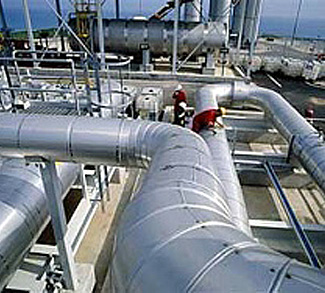
The Strategic Implications of the Turkmenistan-China Pipeline Project
Publication: China Brief Volume: 10 Issue: 3
By:

On December 14, 2009, China and Turkmenistan formally opened the longest natural gas pipeline, which runs from Turkmenistan through Central Asia to China. This pipeline, financed by China National Petroleum Corporation (CNPC)—China’s largest oil and gas producer and supplier—is the first gas pipeline connecting China to Turkmenistan and Central Asia. The Turkmenistan-China pipeline has significant consequences for Central Asia, China as well as Russia. Yet the strategic implications of this pipeline extend beyond Central Asia. It also reflects the future of energy flows in East Asia as both Central Asia and China are becoming increasingly more integrated in their energy supply and other forms of critical infrastructure (e.g. transportation).
The Turkmenistan-China pipeline entails two pipelines and multiple suppliers. The first pipeline, which opened on December 14, travels 1,833 kilometers (KM) (1139 miles) from Turkmenistan through Uzbekistan to southern Kazakhstan then Xinjiang in China. From there the pipeline will connect to China’s domestic pipeline network—ultimately traversing 7,000 km (4,349 miles). While initially Turkmenistan will be the only supplier of gas through this pipeline, by 2011 Uzbekistan and Kazakhstan will open up the second line, which is also 1833 km long, and will enable China to get gas from all three Central Asian producers. Second, the pipeline will deliver China 40 bcm (billion cubic meters) by 2012 if not earlier. Thus, it stands in stark contrast to the Prikaspiiskii (Caspian coastline) pipeline agreement negotiated by Russia with Kazakhstan and Turkmenistan in 2007. Whereas the Turkmenistan-China pipeline was negotiated, signed and built within three years, there has been little progress on the Prikaspiiskii pipeline, which is a reflection of Russian ineffectiveness when compared to the inroads China has made with its Central Asian neighbors (ITRAR-TASS, December 14, 2009; Moscow Times, December 17, 2009) [1].
The opening of these pipelines underscores a changing power equilibrium in the region with a decided advantage for Turkmenistan and the other Central Asian producers, as well as China, but a marked disadvantage for Russia. Turkmenistan has already seen great benefits from this pipeline since the signing of the agreement in 2006, and will continue to them flow for some time. First of all this deal gave Ashgabat negotiating leverage vis-à-vis Moscow, which had consistently forced Turkmenistan to export its gas through the only available pipelines, which were Russian, and at prices well below its market value. Since 2006, however, Turkmenistan’s and other Central Asian states’ leverage over the price of natural gas vis-à-vis Russia has grown as a result of the availability of other export markets beside Russia—namely China. Moreover, as Russia’s dependence upon Central Asian gas increased through 2008 due to escalating global demand, Moscow felt constrained to buy Central Asian gas at a higher price (e.g. $300 tcm), because it believed it could sell it in Europe at $400 tcm. Meanwhile, Central Asian gas would subsidize Russia’s own inefficient and overly subsidized domestic energy economy while trying to meet surging European and Asian demand.
Thus before the current economic crisis unraveled in 2008-09, Moscow had committed to paying $300 tcm to Central Asian producers under the auspices that it could charge Europe $400 tcm [2]. Nevertheless, Moscow consistently sought to get out of paying these prices, especially as the global economic crisis began. After the crisis unfolded and the price of energy resources dropped concomitantly with global demand, however, Moscow was forced buy Central Asian gas at a net loss, which is an increasingly unaffordable burden for Gazprom. Pavel Baev of Norway’s Peace Research Institute (PRIO) observed that Moscow could not directly strike at Kazakhstan or Uzbekistan because it had too many interests engaged with the former, and the latter could defect to the West, therefore it chose Turkmenistan. In April 2009, an explosion along the pipeline brought Turkmen exports to a halt and Moscow delayed opening the line until Turkmenistan reduced its prices, a clear effort to pressure it into submission.
In November 2009, Moscow also reduced the amount of Turkmen gas that it would import in 2010. Gazprom was prepared to buy over 50 bcm from Turkmenistan in 2010-2012 at a price of $375 tcm, but it scaled back its purchases for 2010-12 to 10.5 bcm and wanted to pay Turkmenistan about $220-240 tcm, the same price it is trying to obtain from Uzbekistan and Kazakhstan. Moscow had hoped that its pressure tactics would force Turkmenistan, which depends on gas exports, to scale back the high prices for which it had contracted Moscow in 2008 (Eurasia Insight, November 24, 2009; Moscow Times, December 17, 2009). Yet, Turkmenistan defeated Russia’s plans. First, Turkmenistan employed its new leverage with China to obtain a $3 billion loan from Beijing for the development of Turkmenistan’s South Iolotan gas field with an estimated 4-14 tcm (ITAR-TASS, May 29, 2009). In return, Turkmenistan subsequently raised the amount of gas it committed to export to China through the pipeline from 30 bcm to 40 bcm and granted Beijing the rights to explore and develop the gas fields at South Iolatan to pay off the loan (Central Asia Caucasus Analyst, January 20). Thus, in December 2009 a consortium comprising CNPC, South Korean and UAE companies won contracts to develop the field in South Iolotan (China Daily Online, December 31, 2009). China’s willingness to assist Turkmenistan escape Russia’s hold on Turkmen energy supply has clearly paid off for Beijing, not just in the rapid construction of this new pipeline but also in gaining subsequent contracts and even more gas supplies. This episode clearly demonstrates that China is prepared to counter Russia in Central Asia if the outcome is beneficial to its interests and the price is right, a trend that could have major future implications.
Meanwhile, shortly after the pipeline to China opened, Gazprom and Turkmenistan negotiated an agreement to end the acrimonious squabble that had poisoned relations between them in 2009. Gazprom, however, will only take 10.5 bcm at the lower price that it insisted upon as gas prices on global markets have come down (Eurasia Insight, November 24, 2009). At the same time, Russian officials have tried to put a good spin on the Sino-Turkmen deal by signaling a lack of concern, touting the resumption of gas supplies from Turkmenistan, and reiterating that the new pipeline, by annually shipping 40 bcm of gas to China, will make it impossible for Turkmenistan to supply the EU’s rival Nabucco pipeline that is supposed to compete with Russian pipelines in shipping Central Asian gas to Europe (ITAR-TASS, December 22, 2009).
However, this is whistling past the grave. Even with this agreement it is clear that by 2012, when the two pipelines connecting China with Central Asia open, China, not Russia, will be the main consumer of Central Asian gas, and thus a major alternative to Russia for Central Asian producers. Even if alternatives like Nabucco have been shut off by Russia’s retreat and new agreements (which is doubtful) China’s primacy in the Central Asian gas market is undoubtedly a blow to Russia with long-lasting consequences (ITAR-TASS, December 22, 2009). Indeed, Kommersant suggested that this strengthening of China’s energy position will lead to its becoming the true leader of Central Asia and the “true master” of regional security organizations like the Shanghai cooperation Organization with Russia’s silent assent. Moscow, it argued, has missed its chance in Central Asia by focusing on Europe (Kommersant, December 23, 2009). Even if this is an exaggerated assessment of China’s position in Central Asia, this deal clearly has strengthened China and Turkmenistan as well as other producers at Russia’s expense. What it means is that China no longer approaches Russia with regard to gas as a supplicant; rather, it has a strong bargaining position because it does not have to depend solely on Russia for its gas supply. Indeed, Moscow’s actions depart from its rhetoric. In late December 2009, Moscow reached an agreement with Askhabad to buy 30 bcm (not 10.5bcm) annually of Turkmen gas starting in 2010 and to build a new pipeline to link untapped gas reserves in eastern Turkmenistan with the Prikaspiiskii pipeline (Financial Times, December 22, 2009).
As a follow up to that victory, Turkmenistan is consolidating its diversification policy by also building a new gas pipeline to Iran. That pipeline will reportedly carry 20 bcm of gas even though Turkmenistan is only shipping 8 bcm annually to Tehran, so Turkmenistan will likely increase its ability to supply Iran, thereby adding more diversity to its customer base (Asianews.it, January 8).
Moreover, despite the Russo-Chinese agreements of 2009 to build pipelines to ship China 68 bcm of gas, Russia neither has the money to build the pipelines, nor possibly the gas—as it closed many fields due to the current crisis—unless China lends it the money to reactivate pipelines, wells and fields that were shut down in 2009 due to the economic crisis.
Indeed, China already produces 76 bcm of gas each year and consumes only about 80 bcm, with Australian LNG making up the difference. So it really does not need Russian gas anytime soon, especially as it will now be getting 40 bcm from Turkmenistan (Cbsnews.com, October 14, 2009). In any case, neither side has yet to agree on a price so their pronouncements are merely declarations in principle, not hard contracts, and to judge from previous negotiations, no agreement is imminent. In spite of Russian claims to the contrary, hard bargaining on price is to be expected as China will demand below market prices and Russia will demand market prices in a classic confrontation between supplier and buyer. Indeed, Russia needs this pipeline and its revenues more than China does, and therefore the Turkmen-China pipeline could ultimately contribute to expanding China’s increasingly visible ascendancy over Russia, not just in Central Asia, but in East Asia as well.
Notes
1. Open Source Center, Analysis; PRC, Central Asian Media Laud Gas Line: Russian Officials Downplay Impact,” Open Source Center: Foreign Broadcast Information Service, Central Eurasia, (Henceforth FBIS SOV), January 5, 2010.
2. John Roberts, “Russia and the CIS: Energy Relations in the Wake of the Russia-Ukraine Gas Crisis,” European Union Institute for Security Studies, Opinion, NO. 10, March, 2009, www.iss-eu.org.
[The views expressed here do not represent those of the U.S. Army, Defense Department or the U.S. Government.]





